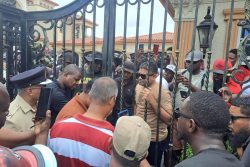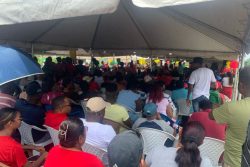The murder of Mr Farouk Kalamadeen marks another bloody milestone in the history of crime in this country. It was not so much that he was killed – although that in itself was disturbing enough – it was the mutilation of his body which so appalled citizens. It is not the first time there has been a decapitation; there was one three years ago in Second Street, Agricola, which was said at the time to have been linked to drug gangs. However, in this instance, of course, Mr Kalamadeen had been held hostage for four weeks prior to his death. Considering that his family say that they received no ransom demand during that time, it makes the motive for his kidnapping and subsequent murder something of an enigma.
What the public is aware of is that this level of barbarity is usually associated with the drug cartels, but whether or not Mr Kalamadeen was involved in any kind of shadowy activity alongside his legitimate business – his family is adamant that he was not – he was certainly targeted by someone utterly ruthless whose actions were intended as a gruesome message to those who knew how to read it. It might be mentioned that those who were around during the events of 2002 will recall that he was one of the residents of Dadanawa Street, Campbellville, who returned fire when the five escapees conducted a sortie in the street, although whether that incident has any relevance to his kidnapping and murder six years later is difficult to say.
That aside, there was a second possible message too. Mr Kalamadeen’s trunk was dumped just around the corner from police headquarters. Prima facie, at least, this seems a case of the killers making a point to the forces of law and order. Then yesterday, the head was found only a corner away from Mr Kalamadeen’s business place. It was significant that a few hours before the main body was found, East La Penitence Police Station had been strafed in the same way that police headquarters had been fired on prior to the Lusignan slaughter. In neither instance does there seem to have been any determined effort to try and kill anyone or enter the compound; it was more a case of raking the area – or where the La Penitence station was concerned – the building, with gunfire.
In other words, it theoretically could have been a diversionary tactic, to cause the police to concentrate their resources in a location far removed from the one where the criminals intended to be active. In our Friday edition we reported that the police had matched the spent shells found at the East La Penitence Station to those found at the scene of the Lusignan and Bartica killings – the first time the GPF had linked the last two – although President Jagdeo had pre-empted the force long ago by announcing two days after the Bartica slaughter that the murderers were the same in both cases.
The police also said that ballistics results linked the La Penitence shells to a robbery/murder in Canal Number 2, WBD in 2006, while Minister of Home Affairs Clement Rohee told the National Assembly in March that spent shells found at Bartica had been used to commit killings and robberies at Better Hope, Sheribana and Triumph last year. (Unlike the President, he did not indicate a connection between Lusignan and Bartica.) The real problem is that the populace has become extremely cynical about police ballistics tests; the Buxton-Agricola gang has been held responsible for almost every major incident involving firearms in the last two years or so – certainly from Sash Sawh’s murder onwards – and the linkages to almost every significant gun crime in the land, among other things, strain credibility in the opinion of some observers.
Leaving aside the matter of ballistics results, does the modus operandi of the killers in the Kalamadeen case – the possible diversionary tactic on the police station and the cold-bloodedness of the crime – suggest that the same people were involved as at Lusignan? Certainly no ordinary member of the public is in a position to hazard a guess, and even for the police one presumes, it must remain at this stage a hypothesis, and not the only one either.
Minister of Home Affairs Clement Rohee did not inspire confidence that the requisite analysis was being applied to the situation. He told this newspaper on Wednesday that the attack on the East La Penitence Police Station was an indication that the armed gangs had resurfaced with a plan to create terror and instability. If, of course, there is a nexus between the dumping of Mr Kalamadeen’s body and the attack on the police station, the message (which would relate to the primary motive) being sent by the criminals may be a lot more specific than the Minister appears to be giving credit for – although certainly creating fear and terror is invariably a secondary motive in these situations.
Furthermore, the Minister could not resist trying to make political mileage by seeming to connect the shooting up of the station with the PNCR’s statements about making Carifesta unmanageable. Leaving aside the main opposition’s doomed quest to make the festival ‘unmanageable,’ not to mention the total inappropriateness of its call, it really more than stretches credulity to link this with the strafing of the station. The public is not interested in the governing party scoring political points at this stage; what they want is the major crimes in this country solved, and in the interim, some evidence that the authorities are applying the requisite forensic skills both literally and metaphorically to addressing the problem.
For all the brave words which have issued from the Ministry of Home Affairs in the last six years about confronting armed criminals, there is little to show for these in terms of results. We now have another gruesome murder to add to the list of violent crimes, and this one has some distinctive features. Will the authorities reassure understandably nervous citizens that they are addressing the questions which it raises in a more sophisticated manner than the statements which some spokesmen have made, suggest.






